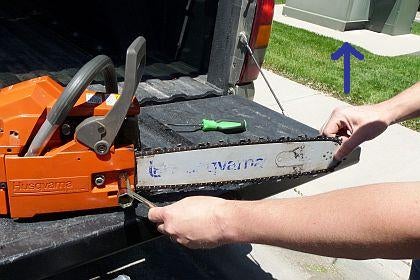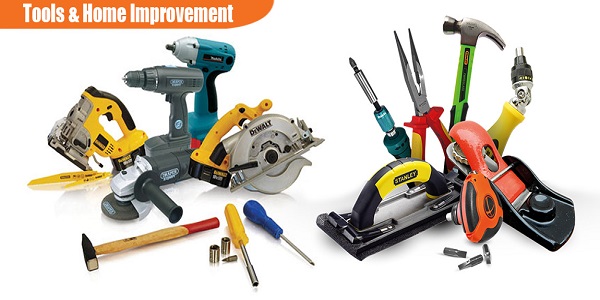To tighten a chain on a Husqvarna chainsaw, first ensure the chainsaw is turned off and cool. Locate the tension adjustment screw, usually near the guide bar, and turn it clockwise to tighten the chain.
Check the tension by pulling the chain; it should snap back into place easily. A well-maintained chainsaw makes cutting tasks safer and more efficient. Keeping the chain properly tensioned is crucial for performance and safety. Chainsaws, like those from Husqvarna, need regular adjustments to ensure they operate smoothly.
A loose chain can jump off the bar or cause uneven cuts, while an overly tight chain can wear out the motor quickly. This guide will walk you through the simple steps to adjust your chainsaw chain, ensuring it remains in optimal condition. Whether you’re a seasoned logger or a weekend warrior, understanding this basic maintenance task can save you time and frustration.
Chainsaw Basics
Chainsaws are incredibly handy tools, whether you’re trimming trees or cutting firewood. Understanding the basics of your Husqvarna chainsaw can make all the difference in efficiency and safety. By grasping the essentials, you can tackle your tasks with confidence and ensure your chainsaw runs smoothly.
Parts Of A Chainsaw
Every chainsaw has several key components. The chain, bar, and engine are the heart of the machine. The chain does the cutting, the bar guides the chain, and the engine powers it all. Familiarize yourself with the tensioner screw; it’s crucial for adjusting chain tension.
Think of the guide bar as the backbone—it keeps the chain aligned during operation. The chain brake adds a layer of safety by halting the chain when needed. Understanding these parts helps you maintain your chainsaw effectively.
Importance Of Chain Tension
Chain tension is vital for efficient cutting and safety. A loose chain can derail and cause damage to the saw or injury to you. A tight chain ensures smooth operation and prevents unnecessary wear on the bar and engine.
Consider the last time your chainsaw didn’t cut as expected. It might have been a chain tension issue. Proper tension keeps the chain running at optimal speed, reducing strain on the engine and improving cutting precision.
Ask yourself: Is your chainsaw cutting like it should? If not, adjusting the chain tension might be the simple solution you need. Keep the tension consistent, and your chainsaw will thank you with better performance.

Credit: www.youtube.com
Tools Needed
Gather essential tools like a wrench and screwdriver for tightening the chain on your Husqvarna chainsaw. These basic items help adjust the tension and secure the bar nuts, ensuring safe and efficient operation. Always keep them handy for quick maintenance.
Tightening a chain on your Husqvarna chainsaw might seem like a daunting task, but with the right tools, it becomes straightforward and manageable. Knowing what you’ll need before you start can save you time and frustration. Let’s dive into the essential equipment and safety gear you’ll require to ensure a smooth and safe process.Essential Equipment
Begin with a wrench or scrench. This handy tool, a combination of a screwdriver and a wrench, is specifically designed for chainsaws. It allows you to adjust the tensioning screws with ease. You’ll also need a flat-head screwdriver. This is crucial for adjusting the tension screw, ensuring the chain is neither too tight nor too loose. Keep a clean cloth nearby. It helps in wiping away any dirt or debris that may interfere with the adjustment process, allowing you to work efficiently.Safety Gear
Safety should always be your top priority. Wear protective gloves to safeguard your hands from sharp edges and potential injuries. Chainsaw chains can be surprisingly sharp, even when not in motion. Consider using safety goggles to protect your eyes from flying debris or accidental splashes of oil. You never know when a small particle might head your way. Lastly, wear ear protection. While you might not be running the chainsaw during the adjustment, it’s good practice to protect your hearing during any maintenance work. Have you ever found yourself struggling with unexpected issues because you didn’t have the right tools at hand? Remember, preparation is key. Equipping yourself with these tools not only makes the task easier but also keeps you safe. By ensuring you have the right equipment and safety gear, you set yourself up for success. Whether you’re a seasoned pro or a chainsaw novice, having these tools within arm’s reach makes all the difference.Preparing The Chainsaw
Preparing your Husqvarna chainsaw is a crucial step before tightening the chain. This process not only ensures safety but also enhances the performance of your chainsaw. By taking a few simple preparatory steps, you can achieve a smoother operation and avoid any potential hiccups that might come your way. Let’s dive into how you can effectively prepare your chainsaw for chain tightening.
Inspecting The Chainsaw
Before you even think about tightening the chain, take a moment to inspect your chainsaw thoroughly. Check the body for any visible damage or wear. Look for cracks or dents that might affect functionality.
Don’t forget to inspect the chain itself. Ensure it’s not overly worn or damaged. A compromised chain can lead to dangerous situations, so it’s vital to ensure it’s in good condition.
Examine the tensioning system too. If parts are missing or damaged, it might be time for replacements. A quick inspection can save you a lot of trouble down the line.
Cleaning The Chain
Cleaning the chain is often overlooked, yet it plays a significant role in the longevity and efficiency of your chainsaw. Dirt and debris can accumulate in the chain links and guide bar, causing friction and wear.
Start by using a brush to remove excess dirt and sawdust. A clean chain reduces resistance, allowing for a smoother cut and less strain on the engine.
Consider using a degreaser to remove any stubborn grime. A well-maintained chain not only cuts better but also helps extend the lifespan of your chainsaw.
Why compromise performance when a simple cleaning can make such a difference? As someone who once ignored this step, I learned quickly how essential it is for optimal operation.
Now, as you prepare your chainsaw, think about how these steps can make your next job easier and safer. Are you ready to tackle the next project with confidence?
Steps To Tighten The Chain
Tightening a chainsaw chain is crucial for safe cutting. A loose chain can cause trouble. Follow these steps to ensure your chainsaw runs smoothly. Take your time. Safety comes first.
Loosening The Nuts
Start by locating the guide bar nuts. Use a wrench to turn them. Loosen the nuts slightly. This allows the bar to move freely. Check the chain for tension. It should be loose enough to adjust.
Adjusting The Tension Screw
Find the tension screw near the guide bar. Turn the screw clockwise. This tightens the chain. Keep turning until the chain fits snugly. Avoid over-tightening. The chain should still move a little.
Once adjusted, tighten the guide bar nuts. Make sure the chain is secure. Test the chain by pulling it away from the bar. It should snap back quickly. This indicates proper tension.
Checking Chain Tension
Regularly checking the chain tension of your Husqvarna chainsaw is crucial for both safety and performance. A loose chain can lead to accidents, while an overly tight chain can cause premature wear. Understanding how to assess and adjust the tension ensures that your chainsaw runs smoothly and efficiently.
Testing The Tightness
Begin by ensuring your chainsaw is turned off and cooled down. Grasp the chain in the middle of the guide bar and gently pull it upwards. Ideally, the chain should lift slightly but not come off the bar completely.
If the chain slips off easily, it’s too loose. Conversely, if it barely moves, you might need to loosen it a bit. Remember, the right tension keeps the chain secure without restricting its movement.
Signs Of Proper Tension
Check that the chain snaps back into place after you release it. This is a good indicator that the tension is just right. The chain should also sit snugly against the guide bar without sagging.
Another sign of correct tension is smooth operation without excessive noise or vibration. If you’ve ever felt the frustration of a chain that jumps or stalls, you’ll appreciate the difference proper tension makes.
Think about the last time you used your chainsaw—was the experience seamless? If not, it might be time to adjust the tension. Paying attention to these small details can save you time and effort in the long run.
Troubleshooting Common Issues
Troubleshooting common issues with your Husqvarna chainsaw chain can save time. It ensures your chainsaw functions effectively and safely. When adjusting the chain, problems like a chain being too loose or too tight often arise. Knowing how to fix these can prevent wear and tear, and improve cutting performance. Let’s explore these issues in detail.
Chain Too Loose
A loose chain can slip off the bar. It decreases cutting efficiency. You might notice the chain sagging or wobbling. This can cause damage to the chainsaw. To tighten a loose chain, locate the tension adjustment screw. It’s usually near the base of the bar. Use a screwdriver to turn the screw clockwise. This increases tension. Ensure the chain moves smoothly along the bar. If it does, you’ve tightened it correctly.
Chain Too Tight
An overly tight chain may hinder movement. It can strain the engine and bar. You might feel resistance when pulling the chain. This can cause overheating or wear. Loosening a tight chain is simple. Find the tension adjustment screw again. Turn it counterclockwise to relieve tension. The chain should have slight slack. Check if it rotates freely around the bar. Proper tension is crucial for optimal performance.
Maintenance Tips
Maintaining your Husqvarna chainsaw is not just a task; it’s a way to ensure safety and efficiency. Tightening the chain correctly is crucial, but regular upkeep is equally important. These maintenance tips will not only extend the life of your tool but also make every cutting job smoother. Let’s dive into some essential practices that will keep your chainsaw running like a charm.
Regular Inspection
Your chainsaw needs regular check-ups just like any other tool. Look for wear and tear signs on the chain and bar. A quick inspection can prevent costly repairs down the road. Make it a habit to check the tension before each use. A loose chain can slip off or damage the saw, while a too-tight chain can cause unnecessary wear. Don’t wait for a problem to arise; proactive checks can save you time and money.
Lubrication Advice
Lubrication is the lifeblood of your chainsaw. Without proper oiling, the chain can overheat and wear out faster. Use high-quality chain oil, and never substitute it with motor oil. Regular lubrication reduces friction and extends the life of the chain. Have you ever felt the chain sticking or slowing down? It’s a clear signal that lubrication is due. Ensure the oil reservoir is always filled before starting your work. It’s a simple step that can make a huge difference.
Now, as you consider these tips, think about this: How often do you really inspect and lubricate your chainsaw? Could a few minutes of maintenance save you hours of trouble later? Consistent care isn’t just a chore; it’s an investment in your tools and safety. Keep your chainsaw ready for action with these straightforward practices.

Credit: www.youtube.com
Safety Precautions
Ensure the chainsaw is off and cool before adjusting the chain. Wear protective gloves to prevent injuries. Keep fingers away from sharp edges and moving parts during the tightening process.
Ensuring safety is a crucial step when tightening the chain on your Husqvarna chainsaw. Failing to follow safety precautions can result in injuries or equipment damage, which no one wants. Let’s dive into some specific safety measures to keep you safe and your chainsaw in great condition.Using Protective Gear
Before you even think about working on your chainsaw, put on the right protective gear. A pair of sturdy gloves not only shields your hands but also provides a better grip, reducing the risk of slips. Safety goggles are essential to protect your eyes from debris or accidental chain snaps. Wearing steel-toed boots adds an extra layer of protection for your feet. Reflect on those moments when you thought, “I wish I had worn better shoes”—it’s not a mistake you want to repeat when handling a chainsaw. A helmet with earmuffs can help protect your head and hearing, especially in a noisy environment.Safe Handling Practices
When handling your chainsaw, ensure it’s completely turned off and the chain brake is engaged. This might seem obvious, but in the rush to get things done, it’s easy to overlook. Taking a moment to double-check can save you from potential hazards. Position the chainsaw on a stable surface before adjusting the chain. It’s like setting a solid foundation before building a house—necessary for stability and safety. Keep your hands clear of the chain and guide bar to avoid any accidental cuts. Consider the last time you adjusted your chainsaw. Did you have everything you needed within arm’s reach? Keeping your tools organized and nearby can prevent unnecessary movement and the temptation to rush. What steps can you take today to ensure your workspace is as safe and efficient as possible?
Credit: www.instructables.com
Frequently Asked Questions
How To Tighten The Chain On A Husqvarna?
To tighten the chain on a Husqvarna, first, turn off the saw and ensure it’s cool. Loosen the bar nuts slightly. Adjust the tension screw clockwise to tighten the chain. Ensure the chain snaps back into place when pulled. Finally, retighten the bar nuts securely.
Why Does My Husqvarna Chainsaw Chain Keep Coming Loose?
A loose chain may result from improper tension adjustment, worn bar or chain, or insufficient lubrication. Ensure the tension is correct, check for wear and lubricate properly. Regular maintenance and inspection can prevent frequent loosening. If problems persist, consult a professional for further diagnosis and repair.
How To Tighten A Loose Chainsaw Chain?
Loosen the chainsaw’s guide bar nuts slightly. Adjust the tensioning screw to tighten the chain. Ensure it fits snugly but can move freely. Tighten the guide bar nuts securely. Always check the chain tension before use for safety.
What Is The L And H On A Husqvarna Chainsaw?
The “L” and “H” on a Husqvarna chainsaw are carburetor adjustment screws. “L” adjusts the low-speed mixture, while “H” controls the high-speed mixture. Proper adjustment ensures optimal engine performance and efficiency. Always follow the manufacturer’s guidelines for adjustments.
Conclusion
Tightening a Husqvarna chainsaw chain is simple with practice. Regular maintenance ensures safe and efficient cutting. Check tension before each use to prevent accidents. Adjust the chain using the side-mounted tensioner for ease. Clean the bar and chain to avoid clogging.
A well-maintained chainsaw lasts longer and performs better. Remember, safety first when handling any power tool. Follow these steps for a smooth operation. Keep your chainsaw in top condition by tightening the chain correctly. Enjoy seamless cutting with a properly adjusted chainsaw.
Your Husqvarna will thank you.


